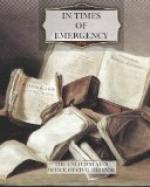People a few miles away—in the “fringe area” of the explosion—would be endangered by the blast and heat, and by fires that the explosion might start. However, it is likely that most of the people in the fringe area would survive these hazards.
People who were outside the fringe area would not be affected by the blast, heat or fire. Department of Defense studies show that in any nuclear attack an enemy might launch against us, tens of millions of Americans would be outside the fringe areas. To them—and to people in the fringe areas who survived the blast, heat and fire—radioactive fallout would be the main danger. Protective measures against this danger can be taken.
WHAT IS FALLOUT?
When a nuclear weapon explodes near the ground, great quantities of pulverized earth and other debris are sucked up into the nuclear cloud. There the radioactive gases produced by the explosion condense on and into this debris, producing radioactive fallout particles. Within a short time, these particles fall back to earth—the larger ones first, the smaller ones later. On the way down, and after they reach the ground, the radioactive particles give off invisible gamma rays—like X-rays—too much of which can kill or injure people. These particles give off most of their radiation quickly; therefore the first few hours or days after an attack would be the most dangerous period.
In dangerously affected areas the particles themselves would look like grains of salt or sand; but the rays they would give off could not be seen, tasted, smelled or felt. Special instruments would be required to detect the rays and measure their intensity.
FALLOUT WOULD BE WIDESPREAD
The distribution of fallout particles after a nuclear attack would depend on wind currents, weather conditions and other factors. There is no way of predicting in advance what areas of the country would be affected by fallout, or how soon the particles would fall back to earth at a particular location.
Some communities might get a heavy accumulation of fallout, while others—even in the same general area—might get little or none. No area in the U.S. could be sure of not getting fallout, and it is probable that some fallout particles would be deposited on most of the country.
Areas close to a nuclear explosion might receive fallout within 15-30 minutes. It might take 5-10 hours or more for the particles to drift down on a community 100 or 200 miles away.
Generally, the first 24 hours after fallout began to settle would be the most dangerous period to a community’s residents. The heavier particles falling during that time would still be highly radioactive and give off strong rays. The lighter particles falling later would have lost much of their radiation high in the atmosphere.




